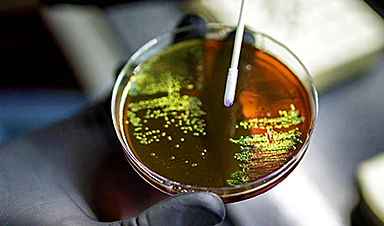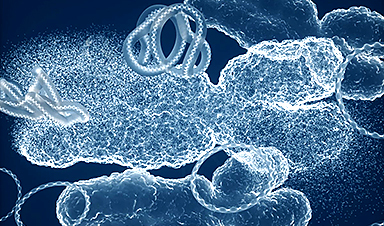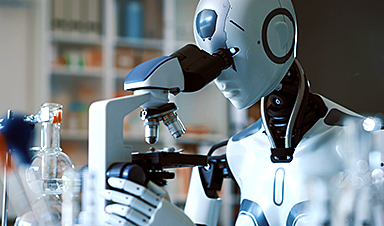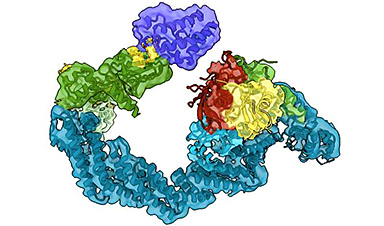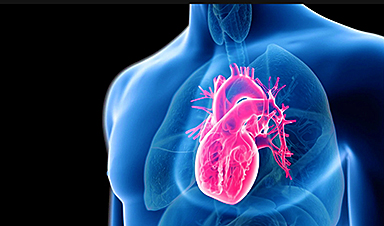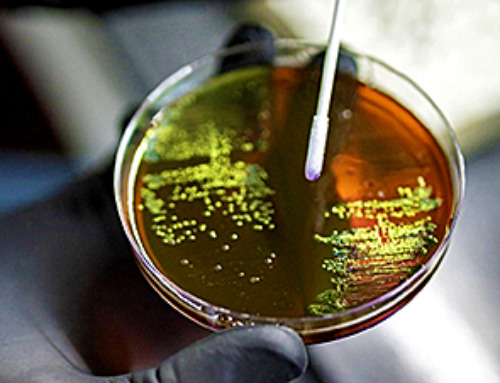Treating cancer can sometimes feel like a game of Whac-A-Mole. The disease can become resistant to treatment, and clinicians never know when, where and what resistance might emerge, leaving them one step behind. But a team led by Penn State researchers has found a way to reprogram disease evolution and design tumors that are easier to treat.
They created a modular genetic circuit that turns cancer cells into a “Trojan horse,” causing them to self-destruct and kill nearby drug-resistant cancer cells. Tested in human cell lines and in mice as proof of concept, the circuit outsmarted a wide range of resistance.
The findings were published today, July 4, in the journal Nature Biotechnology. The researchers also filed a provisional application to patent the technology described in the paper.
“This idea was born out of frustration. We’re not doing a bad job of developing new therapeutics to treat cancer but how can we think about potential cures for more late-stage cancers?” said Justin Pritchard, Dorothy Foehr Huck and J. Lloyd Huck Early Career Entrepreneurial Associate Professor of Biomedical Engineering and senior author on the paper.
“Selection gene drives are a powerful new paradigm for evolution-guided anticancer therapy. I love the idea that we can use a tumor’s inevitability of evolution against it.”
Newer personalized cancer medicines often fail, not because the therapeutics aren’t good, but because of cancer’s inherent diversity and heterogeneity, Pritchard said. Even if a frontline therapy is effective, resistance eventually develops and the medication stops working, allowing the cancer to return.
Clinicians then find themselves back at square one, repeating the process with a new drug until resistance emerges again. The cycle escalates with each new treatment until no further options are available.
“You’re playing a game of Whac-A-Mole. You don’t know which mole is going to pop up next, so you don’t know what is going to be the best drug to treat the tumor. We’re always on our back foot, unprepared,” said Scott Leighow, a postdoctoral scholar in biomedical engineering and lead author of the study.
The researchers wondered if, instead, they could get one step ahead. Could they potentially eliminate resistance mechanisms before the cancer cells have a chance to evolve and pop up unexpectedly? Could they force a specific “mole” to pop out on the board, one that they prefer and are prepared to fight?
What started as a thought experiment is proving to work. The team created a modular circuit, or dual-switch selection gene drive, to introduce into non-small lung cancer cells with an EGFR gene mutation. This mutation is a biomarker that existing drugs on the market can target.
The circuit has two genes, or switches. Switch one acts like a selection gene, allowing the researchers to turn drug resistance on and off, like a light switch. With switch one turned on, the genetically modified cells become temporarily resistant to a specific drug, in this case, to a non-small lung cancer drug.
When the tumor is treated with the drug, the native drug-sensitive cancer cells are killed off, leaving behind the cells modified to resist and a small population of native cancer cells that are drug-resistant. The modified cells eventually grow and crowd out the native resistant cells, preventing them from amplifying and evolving new resistance.
The resulting tumor predominantly contains genetically modified cells. When switch one is turned off, the cells become drug-sensitive again. Switch two is the therapeutic payload. It contains a suicide gene that enables the modified cells to manufacture a diffusible toxin that’s capable of killing both modified and neighboring unmodified cells.
“It not only kills the engineered cells, but it also kills the surrounding cells, namely the native resistant population,” Pritchard said. “That’s critical. That’s the population you want to get rid of so that the tumor doesn’t grow back.”
The team first simulated the tumor cell populations and used mathematical models to test the concept. Next, they cloned each switch, packaging them separately into viral vectors and testing their functionality individually in human cancer cell lines. They then coupled the two switches together into a single circuit and tested it again. When the circuit proved to work in vitro, the team repeated the experiments in mice.
However, the team didn’t just want to know that the circuit worked; they wanted to know it could work in every way. They stress tested the system using complex genetic libraries of resistance variants to see if the gene drive could function robustly enough to counter all the genetic ways that resistance could occur in the cancer cell populations.
And it worked: Just a handful of engineered cells can take over the cancer cell population and eradicate high levels of genetic heterogeneity. Pritchard said it’s one of the biggest strengths of the paper, conceptually and experimentally.
“The beauty is that we’re able to target the cancer cells without knowing what they are, without waiting for them to grow out or resistance to develop because at that point it’s too late,” Leighow said.
The researchers are currently working on how to translate this genetic circuit so that it can be delivered safely and selectively into growing tumors and eventually metastatic disease.
Other Penn State authors on the paper include Marco Archetti, associate professor of biology; Shun Yao, a postdoctoral scholar in biology; Ivan Sokirniy, graduate student at the Huck Institutes of the Life Sciences; and Joshua Reynolds and Zeyu Yang, members of the Department of Biomedical Engineering. Co-author Haider Inam was a doctoral student in biomedical engineering at the time of the research and is currently a research scientist at the Broad Institute of MIT and Harvard. Dominik Wodarz, professor at the University of California, San Diego, also contributed to the paper.
More information: Programming tumor evolution with selection gene drives to proactively combat drug resistance, Nature Biotechnology (2024). DOI: 10.1038/s41587-024-02271-7. www.nature.com/articles/s41587-024-02271-7
News
The Global Nanomedicine Market: Key Players and Emerging Technologies in Healthcare
This article provides an overview of the global nanomedicine market, highlighting key players, emerging technologies, and the challenges and opportunities that influence its growth and commercialization in the healthcare sector. Nanomedicines are nanotechnology-based drug products [...]
Scientists Have Discovered Toxic “Forever Chemicals” in Bottled Water
Scientists have found toxic PFAS in drinking water samples from around the world, with higher levels in tap water from China compared to the UK. Boiling water or using a filtration jug can reduce [...]
Urban Microbes Are Eating Disinfectants – Are We Fueling a New Health Threat?
New research reveals that microbes in urban environments are evolving to withstand the very cleaning agents designed to eliminate them. The study also uncovers new strains in Hong Kong, previously only found in the [...]
Startling Study Shows High-Potency Cannabis Alters DNA
The study shows that frequent use of high-potency cannabis alters DNA, affecting genes related to energy and immune function. These changes differ between those with and without psychosis, suggesting cannabis use could influence mental health through biological [...]
New nanotherapy targets artery inflammation in cardiovascular disease
Inflammation of the arteries is a primary precursor and driver of cardiovascular disease—the No. 1 killer of people in the United States. This inflammation is associated with the buildup of dangerous plaque inside the [...]
Revolutionary Nanoparticle Therapy for Prostate Cancer
A groundbreaking research effort involving teams from the University of Virginia, Mount Sinai, the University of Michigan, the University of Texas, and others has displayed the clinical efficacy of an innovative therapy that utilizes nanoparticles and [...]
Antibody engineering drives innovation in drug development
Monoclonal antibodies (mAbs) are used to prevent, detect, and treat a broad spectrum of non-communicable and communicable diseases. Over the past few years, the market for mAbs has grown exponentially with an expected compound [...]
Breakthrough Study Reveals How Bladder Cancer Starts and Spreads
Researchers found that DNA mutations from antiviral enzymes and chemotherapy fuel early bladder cancer, while abnormal circular DNA in tumor cells drives resistance to therapy. These discoveries open new therapeutic avenues. A groundbreaking study led by [...]
AI and Quantum Mechanics Accelerate Drug Discovery
A recent article published in the Journal of Chemical Information and Modeling researchers at Southern Methodist University (SMU) have developed SmartCADD, an open-source virtual tool designed to speed [...]
Targeting ‘undruggable’ diseases: Researchers reveal new levels of detail in targeted protein degradation
Researchers at the University of Dundee have revealed in the greatest detail yet the workings of molecules called protein degraders which can be deployed to combat what have previously been regarded as "undruggable" diseases, [...]
Revolutionizing Virology: AI Discovers Over 160,000 New RNA Viruses
Largest discovery of new virus species sheds light on the hidden virosphere. Artificial intelligence (AI) has been used to reveal details of a diverse and fundamental branch of life living right under our feet and in every [...]
Cardiac Crisis: COVID-19 Doubles Risk of Heart Attacks, Strokes, and Death
Research indicates that COVID-19 survivors face doubled risks of severe cardiac events for years after recovery, especially if hospitalized. People with A, B, or AB blood types are particularly vulnerable, highlighting the need for personalized approaches [...]
AI steps into science limelight with Nobel wins
For long periods of its history, artificial intelligence has lurked in the hinterland of science, often unloved and unfunded—but two Nobel prizes in one week suggest its time in the sunshine has finally arrived. [...]
MIT Scientists Shed New Light on the Critical Brain Connections That Define Consciousness
A new study provides further evidence that consciousness depends on communication between the brain’s sensory and cognitive regions in the cortex. Our brains are constantly making predictions about our surroundings, enabling us to focus [...]
Common Chemicals Found in Shampoo and Plastic Could Be Quietly Disrupting Your Heart’s Rhythm
UC study of Fernald data links environmental phenols to heart toxicities Environmental phenols are present in numerous everyday consumer products, serving as preservatives in packaged foods, parabens in shampoos, and bisphenol A (BPA) in [...]
Revolutionary Brain Tech Offers New Hope for Stroke and Injury Recovery
University of Pittsburgh researchers report that deep brain stimulation (DBS) can effectively enhance motor functions in individuals with arm and hand paralysis due to brain injuries, with promising results from early human and monkey [...]



